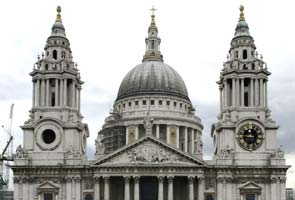
London: St Paul's Cathedral said today it was closing its doors to the public for the first time in modern history because of anti-capitalist demonstrators camped outside the London landmark.
More than 200 activists inspired by the Occupy Wall Street movement have taken over a paved area in front of the cathedral in the city's financial district since last Saturday to protest against corporate greed and state cutbacks.
"I have written an open letter to the protestors this afternoon advising them that we have no lawful alternative but to close St Paul's Cathedral until further notice," said Graeme Knowles, the dean of the cathedral.
"We have done this with a very heavy heart, but it is simply not possible to fulfil our day to day obligations to worshippers, visitors and pilgrims in current circumstances," he said.
He said health, fire and safety officers believed there was a fire hazard from stoves, fires and different types of fuel being used near tents, while there was also a "public health aspect" from waste produced by the protesters.
Knowles said the cathedral authorities shared the protesters concerns about social inequality, but hoped they would "recognise that their voice has been legitimately heard, and withdraw peacefully."
He added: "The decision to close St Paul's Cathedral is unprecedented in modern times."
Knowles however refused to condemn the protesters, saying that they had been peaceful so far and that there was "something profound about protest being made and heard in front of this most holy place".
The protest camp has grown from 70 tents at the start to 150.
The iconic dome of St Paul's has long served as a symbol of London's spirit, particularly during the Luftwaffe's Blitzkrieg bombing campaign in World War II when it escaped damage despite surrounding areas being reduced to rubble.
A church has stood at the site since 604 and the current cathedral, designed by the architect Christopher Wren, was built between 1675 and 1710 after its predecessor had been destroyed in the Great Fire of London.
Princess Diana and Prince Charles married there in 1981.
The church is normally open to paying visitors for an entry fee of 14.50 pounds (16.50 euros, USD 23).
The protesters were due to vote on their next move later on Friday, the Guardian newspaper reported.
Inspired by Occupy Wall Street and Spain's "Indignants",
The Occupy London Stock Exchange protesters set up camp here on Saturday, when about 1,000 people were involved in scuffles with police.
There were protests in 80 countries at the weekend, some of which turned violent, especially in Rome where 135 people were injured.
More than 200 activists inspired by the Occupy Wall Street movement have taken over a paved area in front of the cathedral in the city's financial district since last Saturday to protest against corporate greed and state cutbacks.
"I have written an open letter to the protestors this afternoon advising them that we have no lawful alternative but to close St Paul's Cathedral until further notice," said Graeme Knowles, the dean of the cathedral.
"We have done this with a very heavy heart, but it is simply not possible to fulfil our day to day obligations to worshippers, visitors and pilgrims in current circumstances," he said.
He said health, fire and safety officers believed there was a fire hazard from stoves, fires and different types of fuel being used near tents, while there was also a "public health aspect" from waste produced by the protesters.
Knowles said the cathedral authorities shared the protesters concerns about social inequality, but hoped they would "recognise that their voice has been legitimately heard, and withdraw peacefully."
He added: "The decision to close St Paul's Cathedral is unprecedented in modern times."
Knowles however refused to condemn the protesters, saying that they had been peaceful so far and that there was "something profound about protest being made and heard in front of this most holy place".
The protest camp has grown from 70 tents at the start to 150.
The iconic dome of St Paul's has long served as a symbol of London's spirit, particularly during the Luftwaffe's Blitzkrieg bombing campaign in World War II when it escaped damage despite surrounding areas being reduced to rubble.
A church has stood at the site since 604 and the current cathedral, designed by the architect Christopher Wren, was built between 1675 and 1710 after its predecessor had been destroyed in the Great Fire of London.
Princess Diana and Prince Charles married there in 1981.
The church is normally open to paying visitors for an entry fee of 14.50 pounds (16.50 euros, USD 23).
The protesters were due to vote on their next move later on Friday, the Guardian newspaper reported.
Inspired by Occupy Wall Street and Spain's "Indignants",
The Occupy London Stock Exchange protesters set up camp here on Saturday, when about 1,000 people were involved in scuffles with police.
There were protests in 80 countries at the weekend, some of which turned violent, especially in Rome where 135 people were injured.
No comments:
Post a Comment